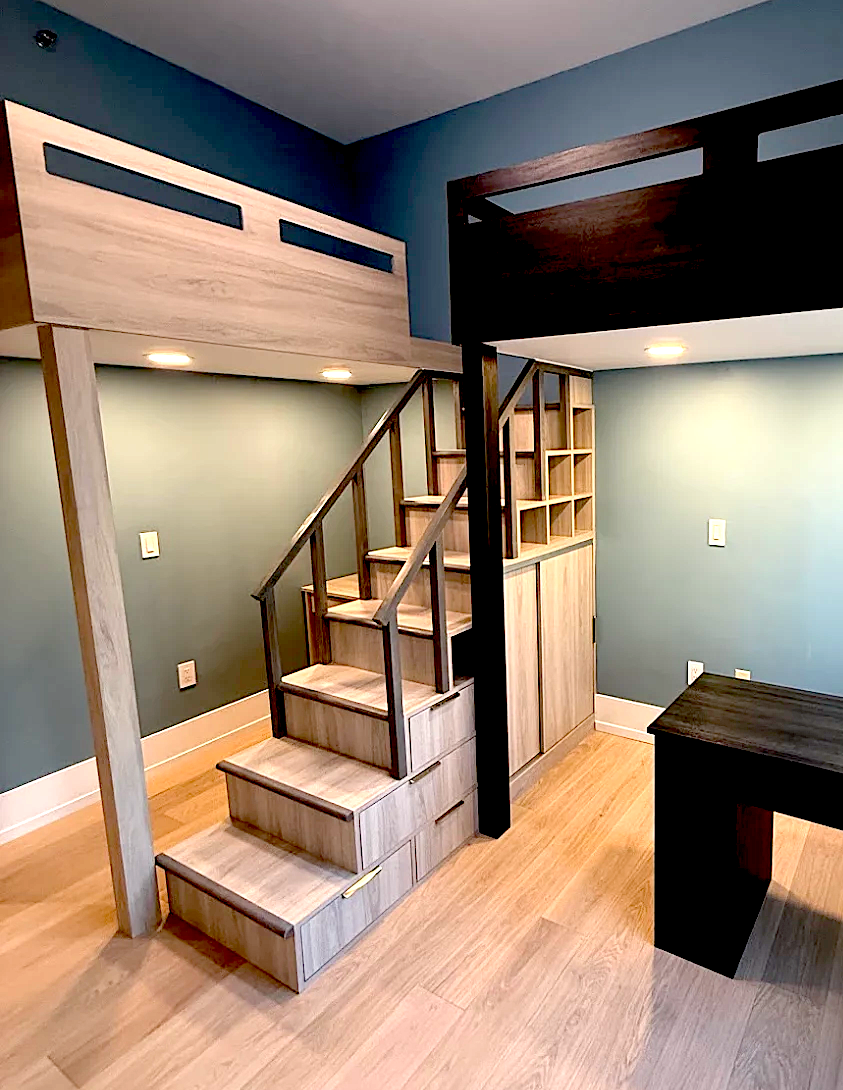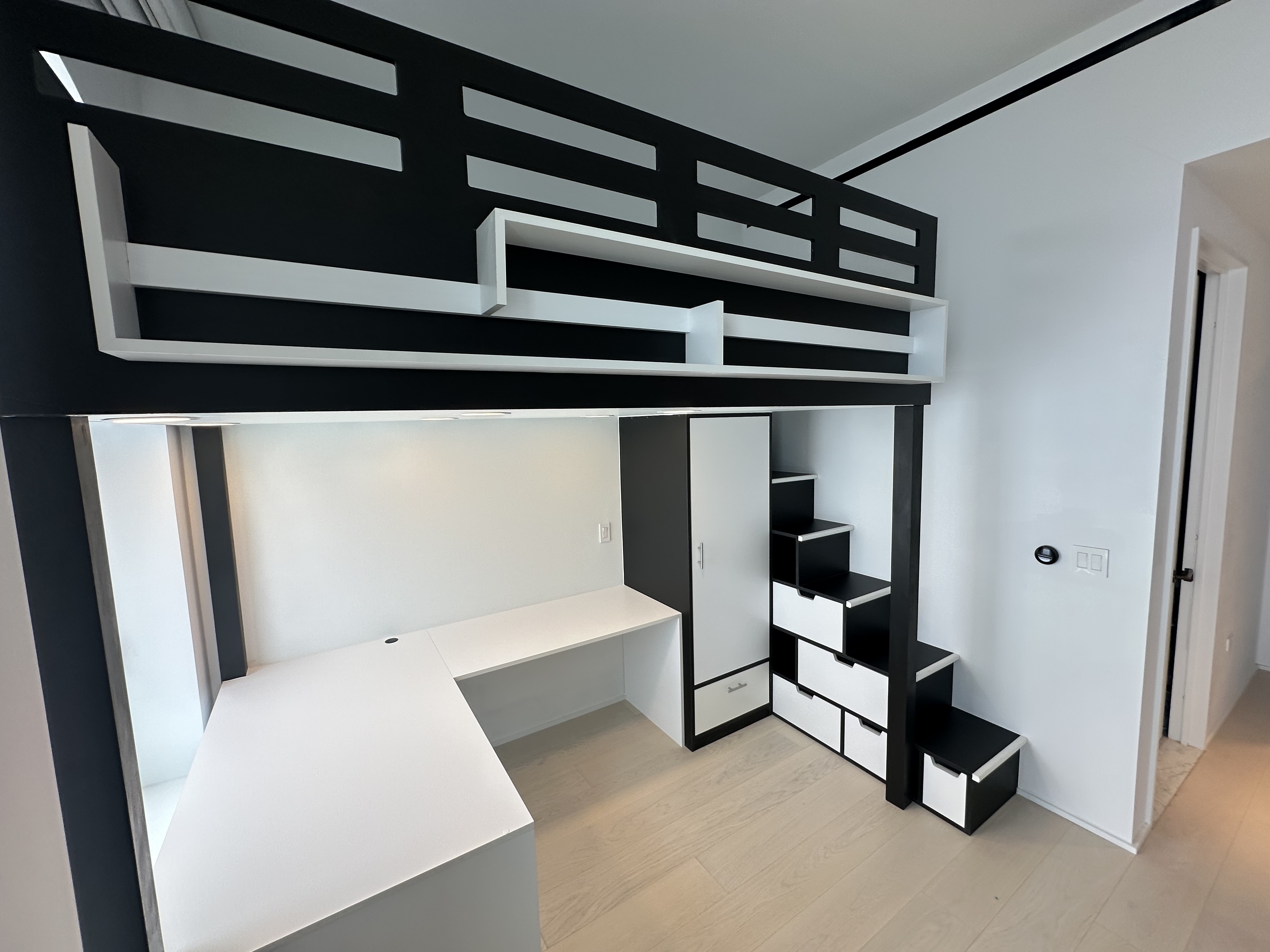Let’s Create Your Space
We’ll provide a tailored quote that reflects your space, style, and goals. Transparent pricing, thoughtful design, and craftsmanship built to last.




Information
+1 347-767-4805
107 27th St, Brooklyn, NY 11232, United States

How high a loft bed should be depends on your ceiling height, who’s sleeping in it, and what you want underneath. With 8 ft ceilings, most lofts sit somewhere between about 55" and 75" tall: low lofts are better for younger kids and simple storage, mid lofts work for kids and pre-teens, and high lofts give teens and adults enough clearance for a real desk or lounge underneath. Aim for roughly 30" of space between the top of the mattress and the ceiling so it doesn’t feel cramped, and make sure the guardrails still sit clearly above the mattress. In NYC apartments, the “right” loft height is the one that balances safe headroom above with enough usable space below, not whatever number is printed on a flat-pack box.
When you start looking at loft beds, you see a lot of fancy photos and not many straight answers. The real question most people have is simple:
“How high is a loft bed supposed to be in a normal room?”
The honest answer: it depends on your ceiling height, who is sleeping there, and what you want to put under the bed. But we can break it down into clear numbers so you are not guessing.
This guide walks through typical loft bed heights, how much space you need above and below the mattress, and how we size custom lofts for tight New York rooms.
If you just want ballpark numbers, here they are.
In a room with standard 8 foot ceilings (96"):
In rooms with 9–10 foot ceilings, you can go even higher and get more space under the bed, but you still need to keep enough headroom above the mattress so it does not feel like a crawlspace.
The goal is to balance three things:
Let’s break that down properly.
When we design a loft at LoftBedsNYC, we always start with three measurements:
Once you know those three numbers, the “how high is a loft bed?” question becomes easy maths.
Here’s a simple way to think about it.
Step 1: Decide how much space you want above the mattress
Most people prefer around 30 inches from mattress top to ceiling so they can sit up without smashing their head.
Step 2: Decide how much space you need underneath
Step 3: Add mattress thickness
Most standard mattresses are 8–10 inches thick. A “low profile” mattress might be 5–6 inches.
Now check if it fits your room.
Example for an 8 foot (96") ceiling, adult loft with desk:
30 + 8 + 54 = 92" total, which fits under a 96" ceiling with a little room for the loft structure itself.
If that total number is higher than your ceiling, you either:
That is exactly what we do when we lay out custom lofts in real New York apartments.
Here’s a more detailed look at the main “height categories” people use.
Best for:
Low lofts keep the sleeper closer to the ground and leave enough space under the bed for toy bins, low shelves, or a cosy reading nook.
Best for:
You might not be able to fit a full adult desk under a mid loft, but you can usually fit a child’s desk, extra storage, or a small seating area.
Best for:
With a high loft in a room with 8 foot ceilings, you still need to pay attention to the mattress and headroom. This is where a low profile mattress and careful planning become important.
These are only suitable in rooms with 9–10 foot ceilings or higher.
They are great when you want:
In a tall New York space, we sometimes run a loft across one end of the room, with a full living or working zone underneath. In short, you are building a mini mezzanine, not just a raised bed.
The right height is different depending on who is using it.
For children, safety and confidence come first.
For kids’ rooms in NYC, we often design lofts around low and mid heights, with stairs that double as drawers so the climb is easy and there is no flimsy ladder.
Teens want space to work, hang out, and put their stuff somewhere that is not the floor.
Adults care about comfort and daily use more than “loft bed vibes”.
This is where off-the-shelf kids’ lofts often fall short. At LoftBedsNYC, we design the height and structure around actual adult use, not just the minimum that passes as “raised”.
You cannot talk about loft bed height without talking about safety.
A few key points:
For custom builds, we always combine the person’s height, the mattress thickness, and the room ceiling to set a safe and practical loft height.
Stock loft beds are sized to fit as many houses as possible. New York apartments are not “stock”.
When we design a loft, we:
The result is a loft that is as high as it needs to be, not as high as a random box label says it is.
If your ceiling is 8 feet, you can still use a loft bed. You just need to:
With 9–10 foot ceilings, you have more freedom and can go higher for extra space underneath.
For an adult to sit at a desk without crouching:
Within reason, yes. With a custom loft, we can:
We will still push back if a height is unsafe or makes the bed uncomfortable to use.
If you are staring at a tape measure and still not sure how high your loft bed should be, that is normal. Send us your ceiling height, a quick sketch of the room, and what you want to put under the loft. We will help you find a height that actually works in real life, not just on a product page.